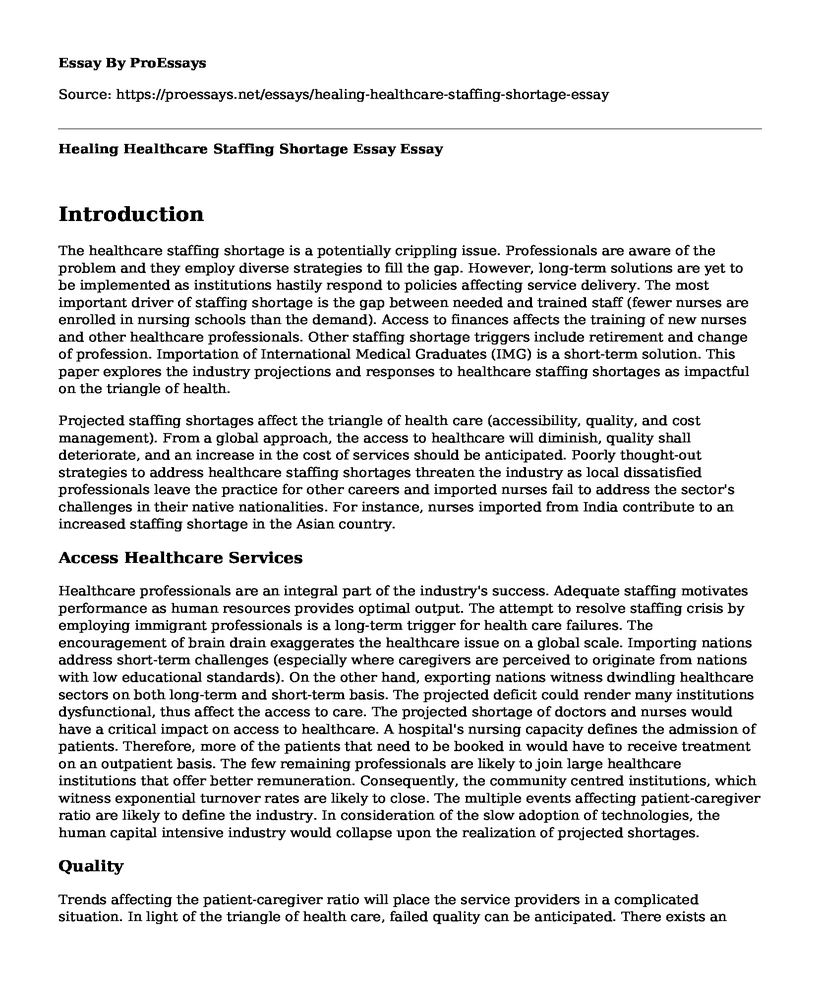Introduction
The healthcare staffing shortage is a potentially crippling issue. Professionals are aware of the problem and they employ diverse strategies to fill the gap. However, long-term solutions are yet to be implemented as institutions hastily respond to policies affecting service delivery. The most important driver of staffing shortage is the gap between needed and trained staff (fewer nurses are enrolled in nursing schools than the demand). Access to finances affects the training of new nurses and other healthcare professionals. Other staffing shortage triggers include retirement and change of profession. Importation of International Medical Graduates (IMG) is a short-term solution. This paper explores the industry projections and responses to healthcare staffing shortages as impactful on the triangle of health.
Projected staffing shortages affect the triangle of health care (accessibility, quality, and cost management). From a global approach, the access to healthcare will diminish, quality shall deteriorate, and an increase in the cost of services should be anticipated. Poorly thought-out strategies to address healthcare staffing shortages threaten the industry as local dissatisfied professionals leave the practice for other careers and imported nurses fail to address the sector's challenges in their native nationalities. For instance, nurses imported from India contribute to an increased staffing shortage in the Asian country.
Access Healthcare Services
Healthcare professionals are an integral part of the industry's success. Adequate staffing motivates performance as human resources provides optimal output. The attempt to resolve staffing crisis by employing immigrant professionals is a long-term trigger for health care failures. The encouragement of brain drain exaggerates the healthcare issue on a global scale. Importing nations address short-term challenges (especially where caregivers are perceived to originate from nations with low educational standards). On the other hand, exporting nations witness dwindling healthcare sectors on both long-term and short-term basis. The projected deficit could render many institutions dysfunctional, thus affect the access to care. The projected shortage of doctors and nurses would have a critical impact on access to healthcare. A hospital's nursing capacity defines the admission of patients. Therefore, more of the patients that need to be booked in would have to receive treatment on an outpatient basis. The few remaining professionals are likely to join large healthcare institutions that offer better remuneration. Consequently, the community centred institutions, which witness exponential turnover rates are likely to close. The multiple events affecting patient-caregiver ratio are likely to define the industry. In consideration of the slow adoption of technologies, the human capital intensive industry would collapse upon the realization of projected shortages.
Quality
Trends affecting the patient-caregiver ratio will place the service providers in a complicated situation. In light of the triangle of health care, failed quality can be anticipated. There exists an inverse relationship between quality of service and quantity of recipients per nurse/physician. An exaggeration of the shortage is bound to affect quality as professionals are forces to meet the needs of more patients. The chances of performing optimally will be affected as caregivers struggle to serve volumes. Performance-based evaluation will fail to exist as nurse and doctors adapt to a crisis work environment. Burnout affects performance. The allocation of fewer patients allows nurses to address minute issues, thus improving the treatment process. on the other hand, overworked caregivers are susceptible to errors. Low nurse-patient ratio affects patient mortality as critical patients do not receive adequate attention. The projected shortages will cause an exaggerated problem in chronic patient care and influence the overall life expectancy. Chronic patients require personalized care, which is achievable with an appropriate medical professional-patient ratio. The quality of end of life care will also diminish. The situation will especially affect the quality of healthcare as the ageing population grows. The older population requires close medical attention, thus physician and nurse hours are likely to increase. Low healthcare quality shall be reported globally as human capital exporting nations suffer exponential staffing shortages.
Cost Containment
The exercise of cost management depends on the forces of demand and supply. The adoption of short-term solutions to the staffing shortage crisis and threat towards nursing education systems seem to lead the United States of America into a crisis. The educational system collapses mean that the deficits in human capital supply must be met through medical graduates imports. However, there is a limit to human capital imports. Persistent staffing shortage creates a situation where the cost of hiring nurses and doctors increases unmanageably. The few available medical graduates will demand premium salaries. From a service point of view, providers are forced to transfer the human capital costs. Therefore, the rapidly increasing human resources costs shall be reflected in consumer budgets. Service recipients will be forced to cover additional costs. The healthcare department shall lose control over cost factors as practitioners dictate the conditions of service. Low-income earners will be denied access to services as healthcare costs rise swiftly.
Conclusion
In conclusion, the healthcare staffing shortage and projected circumstances of service delivery create an impression that access, quality, and cost issues should be anticipated. Decreased accessibility to services shall be reported as healthcare facilities reduce the capacity to address patient needs and charge non-affordable prices. Quality challenges can be anticipated as fewer professionals are forced to attend to more patients in a quantity focused reward system.
Cite this page
Healing Healthcare Staffing Shortage Essay. (2022, Apr 18). Retrieved from https://proessays.net/essays/healing-healthcare-staffing-shortage-essay
If you are the original author of this essay and no longer wish to have it published on the ProEssays website, please click below to request its removal:
- Essay Example - SAFER Guides for EHRs
- The 2010 IOM Report on Nursing's Future and Its Impact Paper Example
- Personal Statement for Nursing Practitioner Program Paper Example
- Current Reproductive and Health Knowledge - Essay Sample
- US Workforce: Reduce Count to Maximize Efficiency - Essay Sample
- Teen Sleep Deprivation: A Link to Mental Health Issues - Essay Sample
- Improving Public Health Through Community Food Projects - Essay Sample







